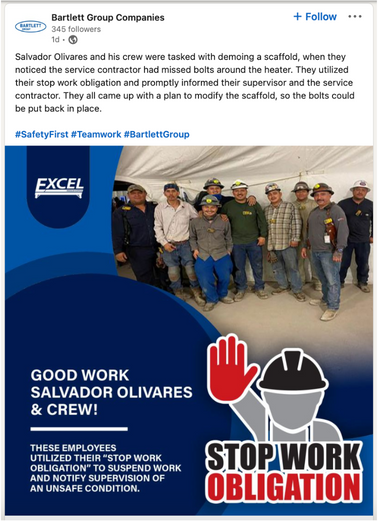Table of contents

Did you know that in the US, non-fatal injury-related missed work days averaged almost 11 days? Had the workers disclosed the near misses that preceded them, many of these incidents would have been avoided.
However, you might be challenged with trying to change the current state of your organization’s near miss reporting culture. Often given the pretense of tattling on coworkers, near miss reporting has been difficult for many companies to strengthen.
To improve the safety culture of near miss reporting, we’ll identify some strategies you can employ to help strengthen your organization’s near miss reporting system.
What is a Near Miss?
A near miss is an incident that could have caused harm, disease, property damage, or fatalities but didn’t because of luck or prompt action. Sometimes called close calls or unplanned events, near miss reporting is essential for workplace safety as it aims to detect and remove dangers, enhance safety performance, and avert more incidents.
For example, a worker may slip on a wet floor, but manage to regain balance and avoid falling. Or a forklift may drop a load, but miss hitting anyone or anything. These are near misses that could have easily resulted in injuries or damages.
Employees frequently overlook or disregard near-miss incidents because they may believe they are not important or pertinent. This is a risky mindset, though, since near misses can be signs of impending dangers and issues at work – not to mention essential for overall OSHA compliance for example. Employees can assist in determining the root cause of potential hazards, putting corrective action measures in place, and preventing the recurrence of similar situations by reporting near misses.
Barriers to Near Miss Reporting
Even while reporting near misses has advantages, many employees could be reluctant to do so for a variety of reasons. Here are just a few possible reasons why this hesitancy may exist:
- Fear of repercussions: Workers could worry that if they disclose near-misses, their peers or bosses will take offense, criticize them, or even fire them. They can be concerned about losing their promotions, incentives, or reputation.
- Complicated reporting procedures: The reporting process of near misses may be perceived by employees as excessively laborious, time-consuming, or unclear. They can be unsure of what information to include or how, when, or where to report near misses.
- Lack of feedback: Workers may believe that it is pointless to record near-misses as their bosses or superiors never acknowledge them, show gratitude, or inquire further. Additionally, they might not notice any enhancements or modifications to the workplace as a consequence of their reports.
Strategies to Encourage Near Miss Reporting
Effective approaches to encourage staff to report near misses must be put in place by companies if they are to get over these obstacles and promote a culture of safety. Among these tactics are:
Gamification
Gamification, which uses game features and mechanics like points, badges, levels, leaderboards, or incentives, can make reporting near misses enjoyable and engaging for your workforce. Bringing out a little friendly competition among co-workers, gamification may take your near miss reporting efforts to a new level. It’s important to monitor this closely, however, as you’ll need to ensure that the incident reporting is accurate and not falsified to earn more rewards.
Here are a few hypothetical instances of how organizations can successfully implement gamification:
- Using a mobile app, workers at a construction company could report near-misses by scanning QR codes at various sites. With every report, workers collected points that they could exchange for incentives like movie or coffee coupons.
- A web-based platform used by a manufacturing organization presents a dashboard containing the total number of near misses recorded by individual departments. When they accomplished certain goals, employees could compare their results with those of others on a leaderboard and earn badges.
- A tablet-based system being used by a healthcare company allows staff members to report near misses by snapping pictures and responding to brief questions. Each report earned a star, and employees had the opportunity to enter a monthly drawing to win gifts like gift cards or spa vouchers.
Abandoning Quota Tracking
Because quota tracking can foster rivalry and pressure among staff members, who may then turn to fabricating or inflating reports to reach the quota, it might discourage reporting.
By pushing staff to prioritize number over quality, quota tracking can also lower the caliber and value of near-miss reports. Workers may report insignificant or unrelated events that don’t require action or pose a serious risk.
Organizations reporting near misses should prioritize quality and accuracy above quantity. Organizations must establish unambiguous norms and criteria that specify the parameters of a near miss and the safety management data that must be included in the report. Businesses should keep an eye on and audit the reports to ensure their legitimacy and dependability.
Confidentiality
By fostering a climate of trust and lowering fears of consequences, confidentiality can promote reporting.
Employees who report near misses can also have their privacy and dignity protected by confidentiality since it helps to avoid unpleasant exposure or rumors. If workers are aware that their identities won’t be disclosed or linked to the occurrence, they could be more at ease and self-assured while reporting future incidents.
Employers should ensure employee names are kept out of training materials and lessons learned reports unless they give permission. Additionally, organizations must restrict authorized personnel’s access to and circulation of near-miss reports.
Simplified Reporting Procedure
By lowering the time and effort needed to submit reports, streamlined reporting processes can promote reporting.
A uniform and structured framework for staff to follow is provided by a simplified reporting system, which can help enhance the consistency and completeness of near miss reports. If workers are aware that reporting near misses is a straightforward process, they could be more inclined to do so.
The following actions can help to expedite the near-miss reporting process:
- Give concise, unambiguous instructions on who to call, what to do, and when to report near-misses.
- Provide a variety of avenues for reporting near-misses, including email, phone calls, mobile apps, and online forms.
- Reduce the amount of information required to report near misses by letting staff members utilize images or videos as proof and simply requesting the bare minimum.
- Automate the near-miss report data entry and analysis process by extracting and organizing the information using software or algorithms.
Recognition and Rewards
Acknowledgment and incentives can promote reporting by raising staff satisfaction and morale.
By demonstrating to workers that their efforts are respected and appreciated, recognition and rewards can also help to reinforce the positive behavior and attitude of those who report near misses. If workers are aware that they will be compensated or given recognition for reporting near misses, they could be more inclined to do so.
The following are speculative instances of how companies could effectively put in place a near-miss reporting incentive and recognition program:
- A company could deploy a lottery system whereby workers who reported near misses would be placed into a monthly drawing to win cash or electronics. The winners’ names and biographies were also released by the business in its newsletter.
- Employees who reported near misses to their superiors could be given points, which they could then redeem for prizes like gift cards or vouchers.
- A peer appreciation program could be implemented to enable staff members who experienced near misses to suggest fellow workers for plaques or certificates.
Here is a great example of simple recognition of employees who identified and reported a near miss:

How Certainty Software Improves Near Miss Reporting
Certainty is a software solution that expedites the process by offering features and advantages that make the near miss reporting process simple, quick, and dependable. With our web-based platform or mobile app, we enable your staff members to submit near misses in minutes. Workers can complete personalized report forms with pre-filled fields and affix documents such as images or videos to serve as proof.
Thanks to Certainty, near miss reports and manual data entry are no longer necessary. With automated report generation, you can now streamline the process of examining reports, whether they are generated by Power BI, System Reports, or your customized reports. With our help, you can track the near-miss reports your employees send and swiftly produce precise preventative or corrective actions to reduce significant worker harm.
Looking to streamline your near miss reporting process? Book a quick call with us to see how Certainty can help.
You might also be interested in:




